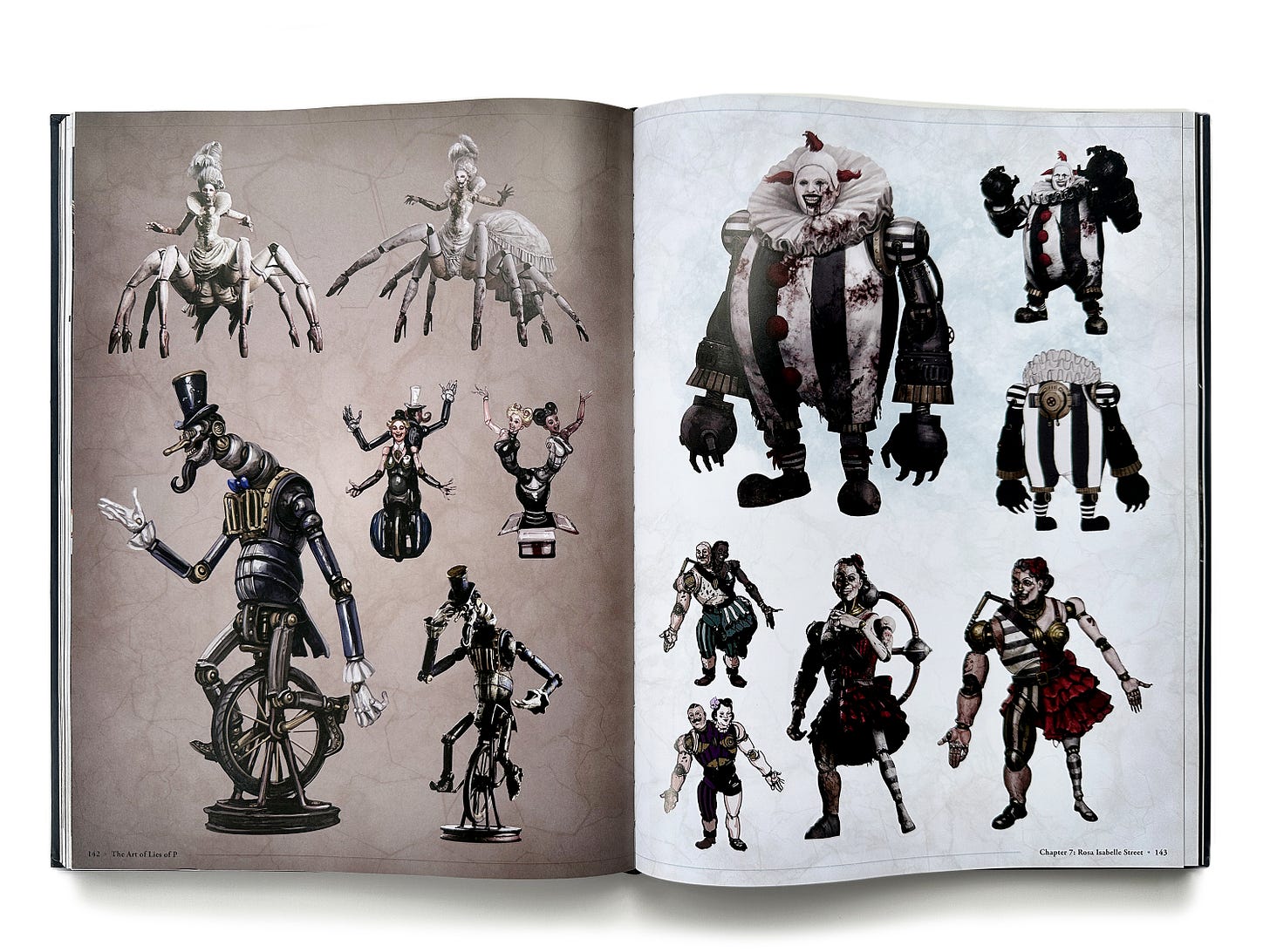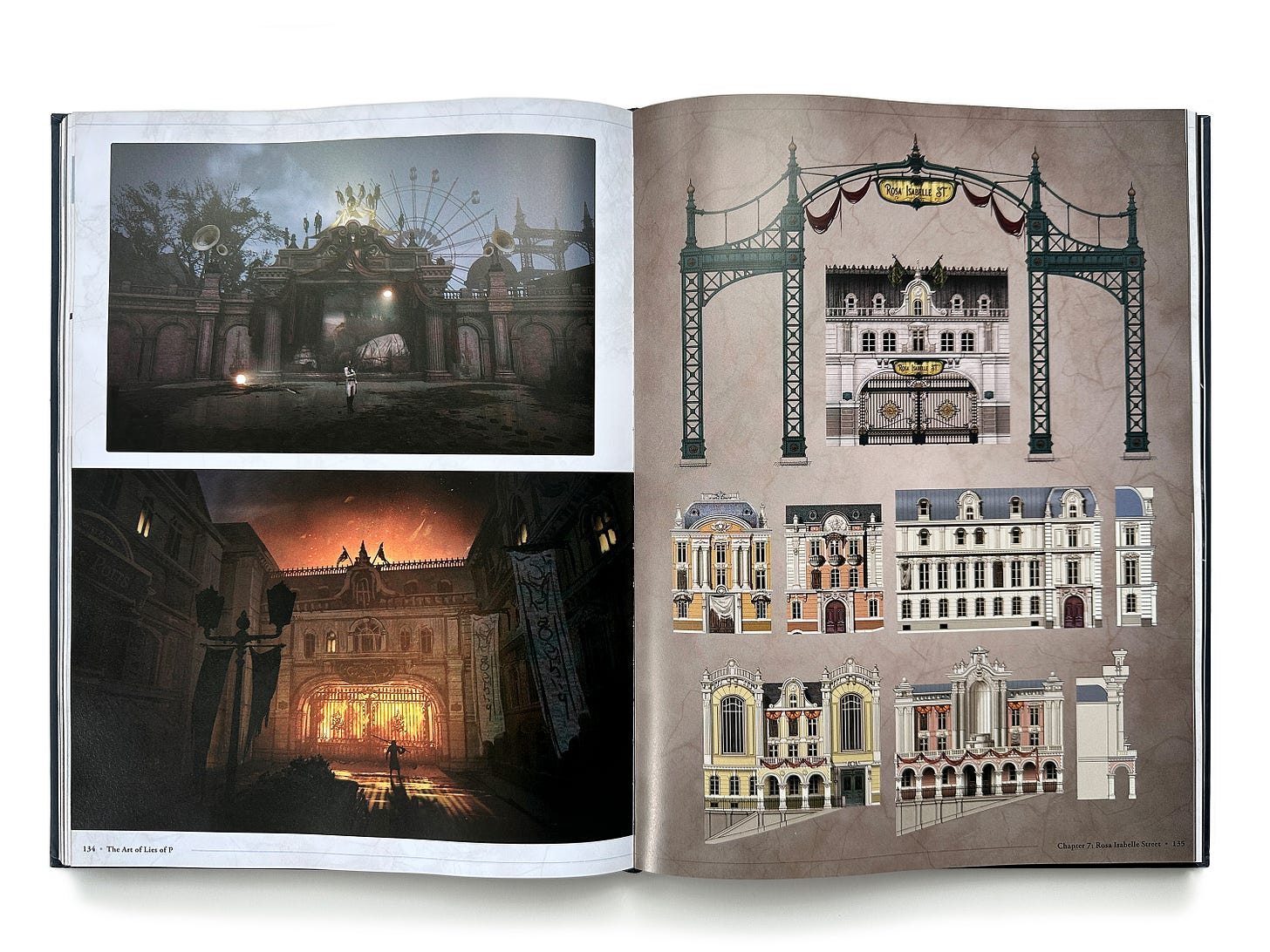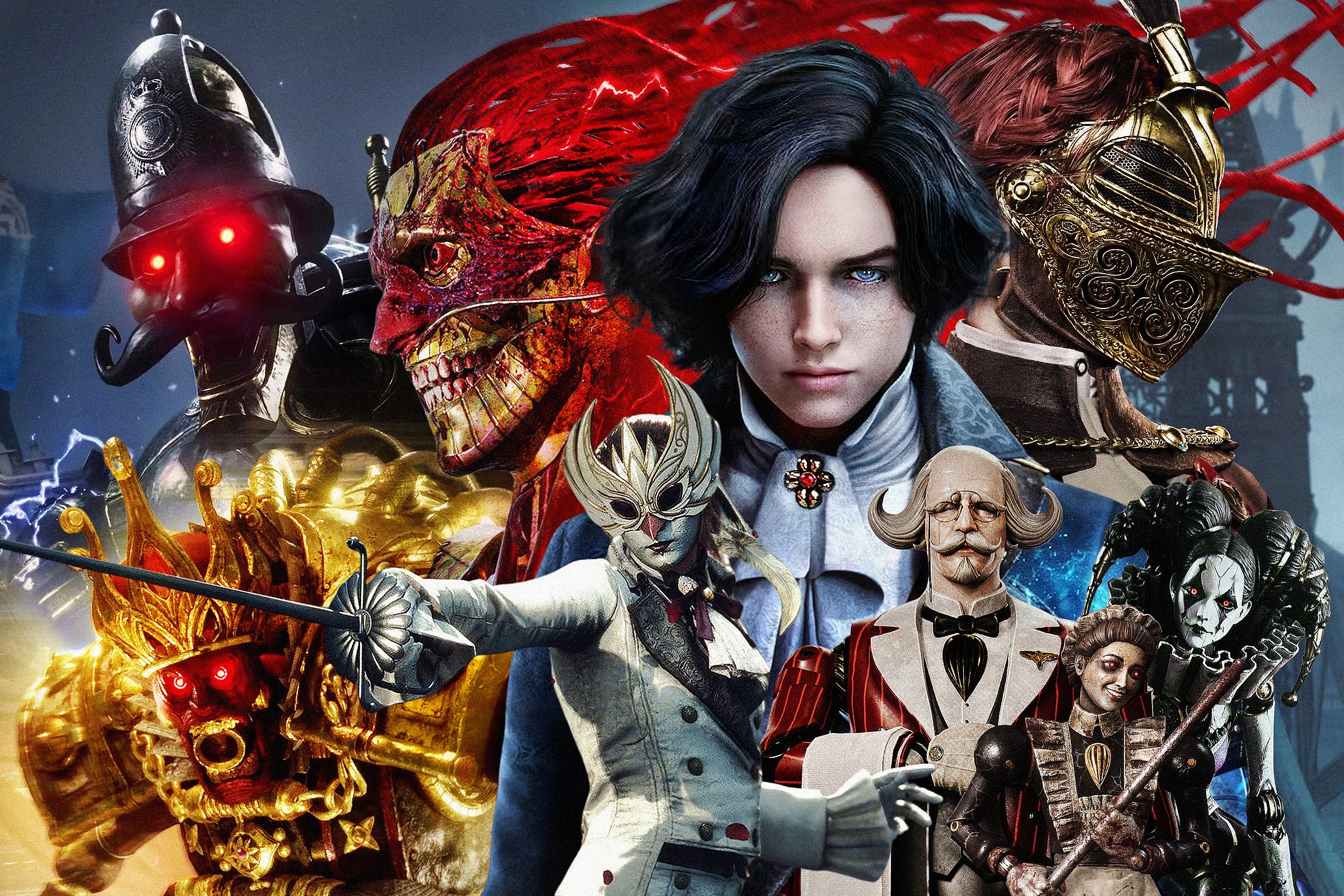Lies of P's puppet punk is peak poetry and pointless zombies
“Perfection is achieved, not when there is nothing more to add, but rather when there is nothing more to take away.” —Antoine de Saint-Exupéry
When Lies of P launched in September 2023, I was hesitant to play it. As a massive fan of FromSoftware, the Japanese developer behind exquisitely crafted and maddeningly, controller-throwing hard video games like Sekiro, Elden Ring, and Armored Core, I (mistakenly) viewed Lies of P—developed by South Korean studios Neowiz and Round8 Studio—as just an inferior copy of the deeply wonderful Bloodborne.
Having now beaten the game twice—including the recent Overture DLC expansion, which contains some of the most creative and best boss fights in the entire game—I am not ashamed to say I was dead wrong. Lies of P owes a lot to Bloodborne, both in visual design and in gameplay, but it is also a skillful labor of love—proof positive that good imitation really is the sincerest form of flattery. Yet, here’s what truly fascinates me: the developers’ clear adoration of Bloodborne’s gothic aesthetic, while a positive influence, has also, in some ways, limited the creative potential of Lies of P.
Before I go any further, here’s some much-needed context: Lies of P is a complete retelling of The Adventures of Pinocchio by Carlo Collodi, the classic fairy tale about the puppet who dreams of becoming a real boy. In the game, Pinocchio is P, a puppet created by his “father” Geppetto. P must learn how to lie to become human—a trait unique to him, as by design, no other puppets can lie or harm a human. The adventure takes place in Krat, a Belle Époque-inspired city of great grandeur and beauty that has been ravaged by the "Puppet Frenzy." This uprising was by the puppets bound in servitude to Krat’s wealthy residents, working as housemaids, butlers, policemen, and soldiers—even puppet children and babies.
To deepen the connection with Collodi’s Pinocchio, several other characters from the book also make an appearance, with a twist. The Black Rabbits are now The Black Rabbit Brotherhood—who incidentally all sound like a combination of Dick Van Dyke in Mary Poppins and Fagin’s Dickensian street urchins in Oliver Twist. Mangiafuoco, meanwhile, is reimagined as Lorenzini Venigni (Lorenzini being Carlo Collodi’s real last name), the inventor and manufacturer of the puppets, and a character a little more benign than Mangiafuoco is in the book. Most notably, the Talking Cricket (Gemini—a nod to Jiminy Cricket in Disney’s Pinocchio) is now a disembodied voice living in P's "Monad's Lamp," and is deeply irritating.
However, it was not the "Pinocchio-ness" of the story that made the greatest impression on me; it was the wonderfully creative design of Lies of P's puppet characters. Non-playable characters like Polendina, Hotel Krat’s concierge (a subtle reference to Geppetto’s nickname “Polendina” in the book), and Pulcinella, Venigni's major domo puppet, are beautifully designed, particularly Pulcinella’s spectacular mustache and hair. But it is the puppet bosses—like the Parade Master, the Scrapped Watchman (a giant mechanical London policeman), the Mad Clown Puppet (a large, somewhat comedic-looking but annoyingly tough mini-boss who guards the path to the Estella Opera House), and Arlecchino the Blood Artist, a major antagonist in the the Overture DLC—that truly stand out in terms of art direction.
The game is filled to the brim with imaginative puppet designs. From those mentioned above to Victorian-style strongmen and eight-legged, Moulin Rouge-esque opera singers, all of which I found astonishingly creative and original. And it’s not just the puppets. Krat itself, with its Beaux-Arts-style architecture, Art Nouveau posters, and sublime detailing, as well as the steampunk science and technology, is a rich visual treasure trove with its own unique style and vibe: from the train station to the opera house to the grand Hotel Krat itself.
Lies of P takes some of the ideas of the Byron-inspired Gothic Victorian vampire horror of Bloodborne and transposes them to the boulevards and grand arcades of a fictitious version of 1889 World's Fair-era Paris. It's an astonishing achievement, remarkably well executed, and feels genuinely original, especially from a relatively new developer. Unfortunately, the developers at Neowiz and Round8 Studio didn’t stop with the puppets and got a little carried away in the process.

While playing Lies of P, I often imagined myself as a fly on the wall during a developers' creative brainstorm meeting, during which someone had stood up excitedly and declared loudly, “These puppets are great, but you know what this game is missing? Zombies!!” Unfortunately for me, there was no pushback.
As a result, Lies of P is a schizophrenic game. It starts as one thing—a puppet-punk elegy—and devolves into all-too-familiar zombie tropes, which I think is a shame. Having set the scene of the residents of a beautiful, steampunk-esque Krat being terrorized by maniacal puppets running amok through the city streets and Venigni’s industrial puppet factory, the game takes a sudden and dramatic left turn in the Path of Misery and St. Frangelico Cathedral areas, and goes decidedly south as a result.
Don't get me wrong, the gameplay is just as good; it's the concept I found disappointing. Instead of dealing with marauding nanny puppets, harlequin dolls, and psycho puppet babies, I found myself being jumped by "Carcassas"—zombie humans infected by the "Petrification Disease," giving them crystalline body horror growths and distorted appendages. It all seems so unnecessary. The story behind the Petrification Disease is interesting enough without them: A band of Alchemists (think mad scientists), in their hubristic pursuit to harness "Ergo" (think Souls) to power Krat's city technology, corrupt the benign puppet servant class in the process, and all hell breaks loose. That's a great plotline on its own; why add zombies into the mix? But wait, there's more.
Back at the creative brainstorm in Seoul, another developer, inspired by the success of the zombie idea, says, “Look, who doesn’t love zombies? But what we really need is a corrupted archbishop monster boss and a battle in a cathedral. That worked a treat in Bloodborne, so we should have one of those too.” As a result, we have to fight a deeply weird (and not in a good way) push-me-pull-you Fallen Archbishop Andreus, which frankly is a borderline comedic character (at one stage, you’re literally fighting the Bishop's butt) and an utter chore of a fight.
Yet what’s worse is that this zombie idea doesn’t end with Fallen Archbishop Andreus. From this point onwards, Lies of P becomes a fusion of psycho puppets (awesome) and zombies (meh)—sometimes both, which does have a slight benefit for the player in that zombies will attack puppets and vice versa. Yet even zombies versus puppets in an Alien vs. Predator-style death match aren’t enough.
The creative brainstorm is now getting decidedly out of hand. A third developer, not to be outdone by the zombie and corrupted bishop ideas, decided it was time to stop fucking around and pitched the slam dunk: “Look, we’ve got puppets, we’ve got zombies, but what we really need is zombie puppets!” At this point, I would have hoped that someone on the team would have politely but firmly suggested that, as much as they loved everyone's enthusiasm, they stick to the initial puppet idea and stop all this mucking about with zombies. I would have loved it if that had happened. Alas, it did not.

I'll never know what Lies of P could have been if the developers had truly committed to its unique, puppet-fueled nightmare. Imagine the further depths of puppet design; more weird and wonderful marvels of Krat's technology; a deeper exploration of the moral ambiguities of a mechanical servant class rising against their human masters, while a lone puppet fights to defend himself against those who would kill him for what he is yet strive to become more human—all unburdened by extraneous neo-gothic horror tropes. What other astonishing creations could we have seen if the developers had simply trusted their own brilliant core idea and run with it?
The Overture DLC, thankfully, offers a small but tantalizing glimpse of that more confident vision. Bosses like Markiona, Puppeteer of Death, and Arlecchino the Blood Artist are genuine masterclasses, the pièce de résistance of the game's creative potential. They prove beyond doubt that Neowiz and Round8 can deliver truly original and captivating encounters when they're not constrained by imitation.
Lies of P is a fantastic video game, a testament to the power of well-executed homage, and without doubt the best Soulslike game not made by FromSoftware I have ever played; it is worthy of respect. But it's also a stark reminder that, in the words of Antoine de Saint-Exupéry, the French author of The Little Prince, true artistic perfection is achieved “not when there is nothing more to add, but rather when there is nothing more to take away." Sometimes, the hardest part of being creative isn't starting, but knowing when and where to stop. We all need an editor to help us “kill our darlings.” And perhaps, for Lies of P, that means cutting out the zombies.
But don’t just take our word for it
A lot has been written and videos made about the influences of Bloodborne on Lies of P and the differences between the two games in terms of mechanics. Here are a few that are rather good examples:
Polygon: Lies of P: Overture’s story elevates an already great game
Estnn: Lies of P Vs Bloodborne: Differences and Similarities
Gaming Bolt: Lies of P Game Director Feels Honored by Comparisons With Bloodborne
📺 Sputnik34 (YouTube): Lies of P Has Ruined Dark Souls For Me
📺 Adam Millard (YouTube): Clones Aren't Killing Gaming - They're Saving It
GameRant: Lies of P: Overture Broke Me, But Not Because of Difficulty
PC Gamer: Lies of P is so blatantly Bloodborne that I feel bad for liking it
Aftermath: Lies Of P: Overture Is The Best Parts Of The Game Executed With Confidence
In other news
I’m somewhat reluctant to talk about my other creative work on MBH4H, but this is an exception: I recently had the privilege of creating the brand identity for Post Games, former Polygon EIC Chris Plante’s new venture, including designing some video game-inspired art. I wrote a bit about the process and shared a gallery of the work over on my Behance page.
Summer Games 2025 has kicked off, with proceeds benefiting Doctors Without Borders. (As of publication, it has raised… exactly $555,555?!) If you need a primer, we wrote about GDQ and speedruns earlier this year. The weeklong event is streaming live on Twitch with breakout runs on YouTube—we recommend this amazing “glitchless” Sekiro run through all bosses.





